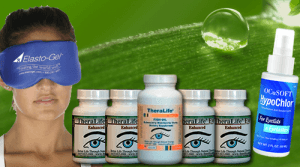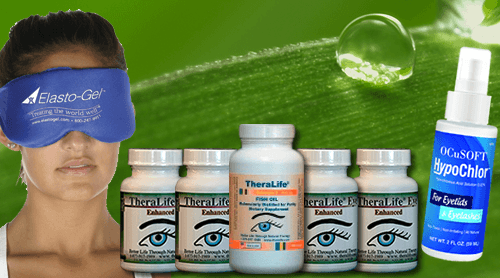Theralife.com offers a comprehensive range of natural solutions for ocular wellness, particularly for conditions like dry eyes and blepharitis. Their products, rich in beneficial ingredients like omega-3 fatty acids, significantly enhance tear film quality and reduce inflammation, which are crucial for healthy eyes.
The Theralife approach combines the benefits of high-quality supplements, such as molecularly distilled fish oil, with other natural strategies to support tear production and maintain ocular surface health. This holistic method not only alleviates symptoms but also tackles the root causes of discomfort.
For those suffering from blepharitis, Theralife’s products provide relief by addressing inflammation and enhancing overall eye health. They offer guidance on effective makeup removal and hygiene practices to manage and prevent flare-ups. The Theralife Eye Enhanced formula is specially designed to support eye health and comfort, offering a natural alternative to traditional treatments.
Consulting with eye care professionals is recommended to ensure precise dosage and safety when using Theralife products. By incorporating these natural solutions into your daily routine, you can elevate your ocular wellness and enjoy relief from chronic conditions. Discover the comprehensive benefits Theralife’s products offer and achieve a higher standard of eye care naturally.
Best Blepharitis Treatment From TheraLife
Add To CartKey Takeaways
- Omega-3 fatty acids in fish oil support tear production and reduce inflammation, benefiting dry eyes and blepharitis.
- Fish oil contributes to the tear film’s lipid layer, minimizing evaporation and enhancing ocular surface integrity.
- Regular omega-3 supplementation shows potential in reducing ocular discomfort and improving tear stability.
- Purified fish oil supplements ensure removal of contaminants, promoting safety and efficacy in eye health management.
- Recommended fish oil dosage is 1,000-2,000 mg of EPA/DHA daily, with triglyceride formulations offering superior absorption.
Understanding Dry Eyes and Blepharitis
Although you may experience occasional eye discomfort, understanding the underlying conditions such as dry eyes and blepharitis can offer clarity on treatment options.
Symptoms identification is essential. Dry eyes are characterized by a burning sensation, redness, and fluctuating vision due to inadequate tear production or excessive tear evaporation. On the other hand, blepharitis presents with eyelid inflammation, crusting, and itching. Clinically, these conditions often coexist, compounding discomfort.
Treatment options should be tailored based on severity and symptomatology. For dry eyes, artificial tears, punctal plugs, or prescription medications like cyclosporine may be effective. TheraLife Eye capsules provide a natural alternative by targeting the root cause of dry eyes: underactive tear production.
Blepharitis management includes eyelid hygiene with warm compresses and lid scrubs. In persistent cases, topical antibiotics or anti-inflammatory agents might be necessary.
Accurate diagnosis guarantees targeted interventions.
The Role of Omega-3 Fatty Acids in Eye Health
You’ll find that omega-3 fatty acids play an essential role in maintaining ocular health by supporting visual acuity and mitigating inflammatory processes in the eye. Clinical studies indicate that omega-3s can enhance tear production, offering potential relief for individuals suffering from dry eye syndrome. Omega-3 fish oil is known to lower the risk of heart disease and stroke, manage triglyceride levels, and benefit mental health.
Omega-3 Benefits Vision
Emerging research has challenged the commonly held belief that omega-3 fatty acids greatly enhance eye health, specifically in alleviating dry eyes. Although omega-3 sources like fish oil are rich in docosahexaenoic acid (DHA) and eicosapentaenoic acid (EPA), clinical trials have produced mixed results regarding their efficacy in improving vision clarity. Some studies suggest potential benefits, indicating that omega-3s might support retinal health and maintain ideal tear production. However, evidence isn’t consistently robust, necessitating further investigation. Omega-3 fish oil is molecularly distilled and 3rd party tested for purity, ensuring high-quality supplementation. You should critically evaluate claims about omega-3 supplements improving ocular health. Discussing treatment options with an eye care professional could provide a personalized approach. While omega-3s contribute to overall health, their direct impact on dry eye symptoms and vision clarity remains a subject of ongoing research.
Reducing Eye Inflammation
While scientific investigation continues to unravel the complexities of ocular health, the role of omega-3 fatty acids in reducing eye inflammation has garnered considerable attention.
Omega-3s, particularly eicosapentaenoic acid (EPA) and docosahexaenoic acid (DHA), exhibit significant anti-inflammatory properties that can positively impact the ocular surface. By modulating inflammatory pathways, these fatty acids help decrease cytokine production, thereby alleviating inflammation associated with conditions like dry eye syndrome and blepharitis.
Clinical studies suggest that regular intake of omega-3 supplements can lead to a reduction in ocular surface discomfort and inflammation. TheraLife Fish Oil, purified via molecular distillation, ensures the removal of contaminants like mercury and PCBs, thus maintaining high quality and purity.
For those seeking a natural approach to managing eye health, incorporating omega-3-rich fish oil into your routine might offer a viable strategy to support ocular surface integrity and reduce inflammation.
Enhancing Tear Production
As researchers explore deeper into the benefits of omega-3 fatty acids, their role in enhancing tear production has become increasingly evident.
Omega-3s, primarily eicosapentaenoic acid (EPA) and docosahexaenoic acid (DHA), are integral to maintaining a healthy tear film and ocular surface. These essential fatty acids contribute to the lipid layer of the tear film, reducing evaporation and stabilizing tear composition.
Clinical studies have shown that supplementation with omega-3 fatty acids can improve tear production and quality, offering relief for individuals with dry eye syndrome. By modulating inflammatory pathways and promoting gland function, omega-3s support the ocular surface’s health.
Incorporating omega-3-rich fish oil into your diet could be a beneficial strategy for enhancing tear production and ocular wellness. Additionally, fish oil supplements may support tear production and eye health, as they are part of alternative treatments that can help manage dry eye conditions.
How Fish Oil Supports Tear Production
Though widely discussed, the efficacy of fish oil in supporting tear production is not conclusively proven. Yet, omega-3 fatty acids in fish oil are thought to play a role in maintaining the tear film, enhancing eye lubrication. The tear film serves as a crucial barrier, protecting the ocular surface and ensuring comfort. Research suggests that fish oil may influence the lipid layer of the tear film, potentially improving stability and reducing tear evaporation. Psychological support may enhance treatment outcomes for individuals suffering from dry eye disease, as mental health can influence the overall management of the condition.
| Key Component | Potential Effect of Fish Oil |
|---|---|
| Tear Film | Enhanced stability |
| Eye Lubrication | Improved lubrication |
| Lipid Layer | Possible influence on lipid layer |
| Tear Evaporation | Potential reduction in evaporation |
| Ocular Comfort | Increased ocular surface protection |
Such findings necessitate further clinical trials to unequivocally establish the role of fish oil in tear production.
Reducing Inflammation With Fish Oil
Fish oil, rich in omega-3 fatty acids, may play a significant role in reducing ocular inflammation, a common contributor to dry eye syndrome.
The anti-inflammatory properties of EPA and DHA, the principal components of fish oil, are well-documented in clinical studies. They modulate inflammatory mediators, which can lead to inflammation reduction in ocular tissues.
By integrating fish oil into your regimen, you may experience fish oil benefits, particularly in the context of reducing inflammation that exacerbates dry eye symptoms.
The reduction of pro-inflammatory cytokines helps maintain the health of the ocular surface. This, in turn, may enhance overall ocular comfort and function.
It’s important to reflect on these benefits when addressing inflammation as part of your strategy for managing dry eye syndrome. Clinically proven methods like TheraLife have demonstrated efficacy in reducing eye dryness symptoms, offering another approach to managing this condition.
Choosing the Right Fish Oil Supplement
When selecting a fish oil supplement for dry eyes, you need to prioritize the omega-3 content, as its concentration is essential for efficacy. Make certain the product undergoes rigorous purity testing to avoid contaminants like mercury and PCBs, which could compromise safety. Additionally, consider the dosage and formulations available to match therapeutic needs and optimize patient outcomes. For those dealing with chronic dry eyes, the TheraLife® Dry Eye Bundle offers a comprehensive solution by including molecularly distilled Omega 3 Fish Oil, ensuring a high level of purity and effectiveness.
Omega-3 Content Importance
Understanding the omega-3 content in fish oil supplements is vital for effectively managing dry eyes. Omega-3 fatty acids are fundamental for ocular health, particularly in improving tear film stability and reducing inflammation associated with dry eyes. To maximize benefits, choose supplements with high eicosapentaenoic acid (EPA) and docosahexaenoic acid (DHA) concentrations. Meibomian gland dysfunction is linked to dry eye syndrome and chalazion formation, highlighting the importance of maintaining meibomian gland health. Consider these omega 3 sources and dietary recommendations:
| Omega-3 Source | EPA/DHA Content |
|---|---|
| Fish Oil | High |
| Flaxseed Oil | Low (ALA, not EPA/DHA) |
| Chia Seeds | Low (ALA, not EPA/DHA) |
| Algal Oil | Moderate to High |
| Krill Oil | Moderate |
Selecting a supplement with ideal EPA/DHA ratios aligns with evidence-based dietary recommendations, supporting ocular wellness. Prioritize clinically validated products to guarantee efficacy and safety in managing dry eyes.
Purity and Contaminants Check
Guaranteeing the purity and absence of contaminants in fish oil supplements is critical for safe and effective management of dry eyes. Contaminant sources such as heavy metals, dioxins, and polychlorinated biphenyls (PCBs) can compromise the supplement’s safety and efficacy. It’s vital to select products that undergo rigorous purity testing. Look for supplements certified by organizations like the International Fish Oil Standards (IFOS) or the United States Pharmacopeia (USP), which verify that contaminant levels are within the permissible limits. These certifications indicate that the product has been tested for purity and has met stringent safety standards. By prioritizing high-quality fish oil supplements, you guarantee the best therapeutic benefits while minimizing potential risks associated with contaminants, thereby supporting ocular wellness effectively. Anti-inflammatory foods can also play a significant role in managing dry eye symptoms when included in an autoimmune diet plan.
Dosage and Formulations
Selecting the right fish oil supplement for addressing dry eyes involves careful consideration of dosage and formulations.
Dosage guidelines typically recommend 1,000 to 2,000 mg of combined EPA and DHA daily for peak ocular health. However, you should consult a healthcare professional to personalize this dosage based on individual needs and health status.
Formulation types vary, with options including triglyceride, ethyl ester, and phospholipid forms. Triglyceride formulations generally exhibit superior absorption and bioavailability, making them preferable for clinical application.
When evaluating supplements, verify they contain at least 60% EPA and DHA for therapeutic efficacy. Prioritize products with third-party certifications to confirm purity and potency, safeguarding against contaminants.
This evidence-based approach enhances the therapeutic potential of fish oil in managing dry eyes.
Incorporating Fish Oil Into Your Daily Routine
To effectively incorporate fish oil into your daily routine, consider the evidence on ideal dosing and timing. Studies suggest that a fish oil dosage of 1,000-2,000 mg of combined EPA and DHA per day can enhance ocular nutrition and support eye health.
Administering doses with meals may improve absorption and reduce gastrointestinal discomfort. Consistent daily intake is essential for sustained benefits in managing dry eyes and blepharitis.
Start by selecting a high-quality fish oil supplement, ensuring it meets purity and potency standards. You might choose liquid formulations for ease of dosage adjustment or capsules for convenience.
Monitoring your response over time is advisable and consulting with an eye care professional can help tailor the regimen to your specific ocular needs.
Potential Side Effects and Considerations
While integrating fish oil into your daily regimen offers benefits for eye health, it’s important to be aware of potential side effects and considerations.
Fish oil interactions with medications like anticoagulants can increase bleeding risk, necessitating careful monitoring and possible dosage adjustments.
Adhering to dosage guidelines is essential; excessive intake may lead to gastrointestinal discomfort, including nausea or diarrhea.
Clinically, a standard dose ranges from 1,000 to 2,000 mg of combined EPA and DHA per day, but individual needs may vary based on your specific health conditions and nutritional status.
Always consult with a healthcare provider to tailor the dosage appropriate for you, ensuring efficacy while minimizing adverse effects.
Understanding these factors can optimize fish oil’s role in managing dry eyes and blepharitis.
Combining Fish Oil With Other Natural Remedies
As you explore combining fish oil with other natural remedies for managing dry eyes, it’s important to contemplate the synergistic effects these combinations may offer.
Integrating fish oil with herbal remedies such as chamomile or bilberry could enhance ocular surface lubrication and reduce inflammation. Omega-3 fatty acids in fish oil possess anti-inflammatory properties that may complement the antioxidative effects of herbal extracts, potentially optimizing tear film stability.
Select herbal remedies with clinical evidence supporting ocular health benefits. For instance, bilberry’s anthocyanins might support microcirculation, while chamomile may soothe irritated eyes.
Consult with a healthcare professional before initiating any combination to verify safety and efficacy. Tailoring an individualized regimen incorporating fish oil and herbal remedies could provide a thorough approach to alleviating dry eyes and promoting ocular wellness.
Scientific Research on Fish Oil for Eye Health
Emerging research highlights the promising role of fish oil in improving eye health, particularly concerning dry eyes. Clinical studies suggest that omega-3 fatty acids, a key component of fish oil, may enhance the lipid layer of the tear film, reducing tear evaporation and alleviating symptoms of dry eye syndrome.
The anti-inflammatory properties of fish oil benefits ocular health by potentially decreasing ocular surface inflammation associated with blepharitis.
Key findings in scientific research include:
- Omega-3 supplementation has been linked to improved tear stability and reduced symptoms of dry eye.
- Randomized controlled trials demonstrate a significant reduction in inflammatory markers with fish oil intake.
- Meta-analyses support the efficacy of fish oil in enhancing overall ocular health by improving tear production.
These insights underscore the potential of fish oil in therapeutic applications for eye conditions.
Tips for Maintaining Overall Ocular Wellness
To maintain ideal ocular wellness, you should prioritize a balanced diet rich in omega-3 fatty acids, vitamins, and antioxidants, as these nutrients are clinically shown to support eye health.
Incorporating regular eye exercises can enhance visual acuity and reduce eye strain, especially in individuals with high screen exposure.
Evidence suggests that these strategies collectively contribute to the prevention of common ocular conditions and promote overall eye health.
Balanced Diet Importance
A balanced diet is essential for maintaining overall ocular wellness, as it provides essential nutrients that support eye health. Ensuring dietary diversity enhances access to various nutrient sources vital for ocular function.
Omega-3 fatty acids, antioxidants, and vitamins like A, C, and E are integral for reducing oxidative stress and preserving visual acuity. Clinical evidence suggests that these nutrients play a pivotal role in preventing conditions like macular degeneration and dry eyes.
- Omega-3 fatty acids: Found in fish, flaxseeds, and walnuts, they reduce inflammation and support tear production.
- Antioxidants: Present in leafy greens and berries, they protect ocular tissues from damage.
- Vitamins A, C, E: Essential for maintaining corneal and retinal health, available in carrots, citrus fruits, and nuts.
Prioritize a balanced intake to optimize eye health.
Regular Eye Exercises
While often overlooked, regular eye exercises play a critical role in maintaining overall ocular wellness. Engaging in eye yoga can enhance the flexibility and strength of your eye muscles, potentially mitigating symptoms of digital eye strain.
Evidence suggests that structured exercises, such as palming and eye rolling, promote relaxation and improve circulation, contributing to ideal visual function. Implementing visual breaks is essential when working on screens. The 20-20-20 rule—every 20 minutes, look at something 20 feet away for at least 20 seconds—has been clinically recognized to reduce fatigue and discomfort.
Regularly practicing these exercises can augment your eye health by reducing stress and maintaining focus, serving as a natural adjunct to traditional treatments for dry eyes and blepharitis.
Frequently Asked Questions
Can Fish Oil Improve Vision Clarity and Sharpness?
You’re wondering if fish oil can enhance vision clarity and sharpness.
From a clinical perspective, it’s known that omega-3 sources, like fish oil, play a role in vision enhancement. They provide essential fatty acids that may support retinal health and improve overall ocular function.
Some studies suggest a potential benefit, but evidence remains inconclusive.
It’s vital to maintain a balanced diet and consult a healthcare professional for personalized advice regarding ocular wellness.
Are There Specific Fish Oil Brands Recommended for Eye Health?
Remember the story of Achilles, whose strength was legendary?
Think of fish oil as your eyes’ Achilles heel against dryness. When choosing a brand, look for those rich in EPA and DHA, like Nordic Naturals or Carlson.
Clinical studies suggest these can enhance eye health. Follow dosage recommendations on labels to harness fish oil benefits effectively.
Always consult your ophthalmologist to tailor the dosage for your specific ocular needs.
How Long Does It Take to See Benefits From Fish Oil?
When you start taking fish oil, the time to notice benefits can vary due to individual variability.
Typically, evidence suggests noticeable ocular improvements may take a few weeks.
Dosage timing is essential; consistent daily intake optimizes results.
Clinical studies indicate that omega-3 fatty acids need time to accumulate in your system.
If benefits aren’t apparent within several months, consult a healthcare provider to reassess your dosage or explore alternative therapies.
Can Vegetarians Use Plant-Based Omega-3 for Dry Eyes?
Yes, you can use plant-based omega-3 for dry eyes.
Plant sources like flaxseed, chia seeds, and walnuts offer omega-3 alternatives, specifically alpha-linolenic acid (ALA).
While ALA is less potent than fish-derived eicosapentaenoic acid (EPA) and docosahexaenoic acid (DHA), clinical studies indicate some efficacy in alleviating dry eye symptoms.
Make sure you maintain an adequate intake, as conversion of ALA to EPA/DHA is limited.
Consult healthcare professionals for personalized advice.
Is Fish Oil Safe for Pregnant or Breastfeeding Women?
Coincidentally, you’re considering fish oil during pregnancy, which aligns perfectly with its known benefits.
Current evidence suggests fish oil is generally safe for pregnant and breastfeeding women when consumed in recommended doses. Omega-3 fatty acids like EPA and DHA contribute to fetal brain and eye development.
However, make certain you choose supplements low in mercury and PCBs. Always consult your healthcare provider to confirm the pregnancy safety and appropriate dosage for your specific needs.
Conclusion
TheraLife’s products offer a comprehensive approach to enhancing ocular wellness, particularly for those dealing with conditions like dry eyes and blepharitis. By addressing the root causes of these issues, TheraLife’s supplements, enriched with natural ingredients, work synergistically to promote tear production and alleviate inflammation. This holistic approach is supported by scientific evidence and aims to provide relief while minimizing potential side effects.
TheraLife’s product line includes targeted solutions for various eye conditions. For instance, their supplements focus on improving overall eye health, which can enhance comfort and clarity. They also offer specialized treatments for blepharitis, emphasizing the importance of maintaining clean eyelids and proper eyelash hygiene. Additionally, TheraLife provides dietary recommendations and lifestyle advice to complement their products, promoting a well-rounded strategy for managing eye health.
The company’s commitment to natural and evidence-based choices ensures that customers can confidently embrace a path to clearer, more comfortable vision. By leveraging TheraLife’s resources and products, individuals can look forward to maintaining optimal ocular wellness and enjoying improved quality of life.





